A Critical Analysis of Zara Using Keller's Brand Report Card
VerifiedAdded on 2022/11/24
|22
|5527
|332
Report
AI Summary
This report offers a critical analysis of Zara, a fast-fashion company, based on Keller's Brand Report Card, evaluating its performance across ten key traits. The analysis reveals Zara's strengths in delivering customer benefits and staying relevant, while also highlighting areas of concern such as pricing strategy and brand positioning. The report proposes a digital marketing plan designed to enhance Zara's customer base, market share, and overall business sustainability. The analysis covers Zara's product offerings, distribution, competition, and a detailed marketing strategy, including objectives, target markets, and marketing mix. The report's findings suggest that Zara should revisit its brand positioning and pricing strategies to maintain its competitive edge in the fast-fashion market. The report emphasizes the importance of digital platforms and social media for Zara's future advertising and communication strategies.
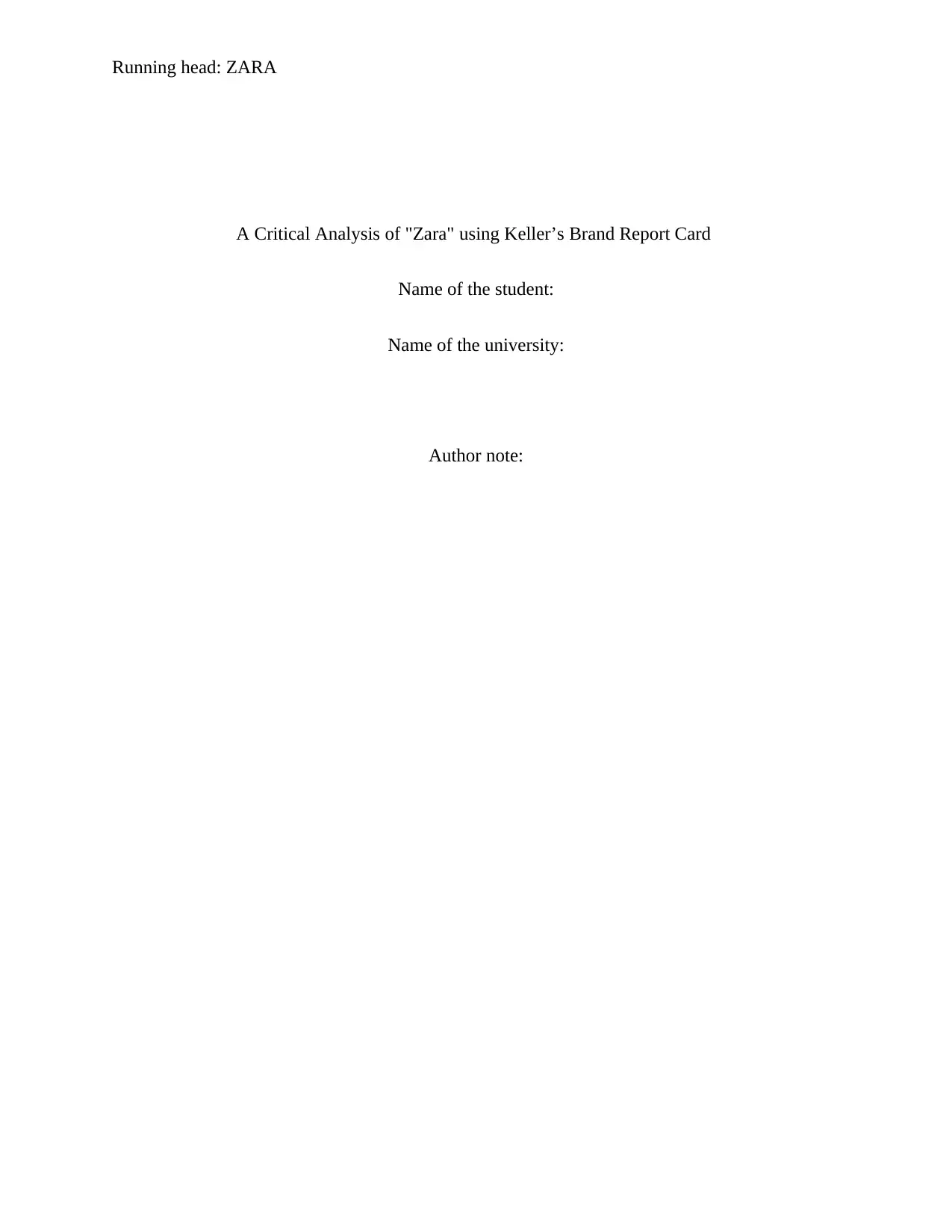
Running head: ZARA
A Critical Analysis of "Zara" using Keller’s Brand Report Card
Name of the student:
Name of the university:
Author note:
A Critical Analysis of "Zara" using Keller’s Brand Report Card
Name of the student:
Name of the university:
Author note:
Paraphrase This Document
Need a fresh take? Get an instant paraphrase of this document with our AI Paraphraser
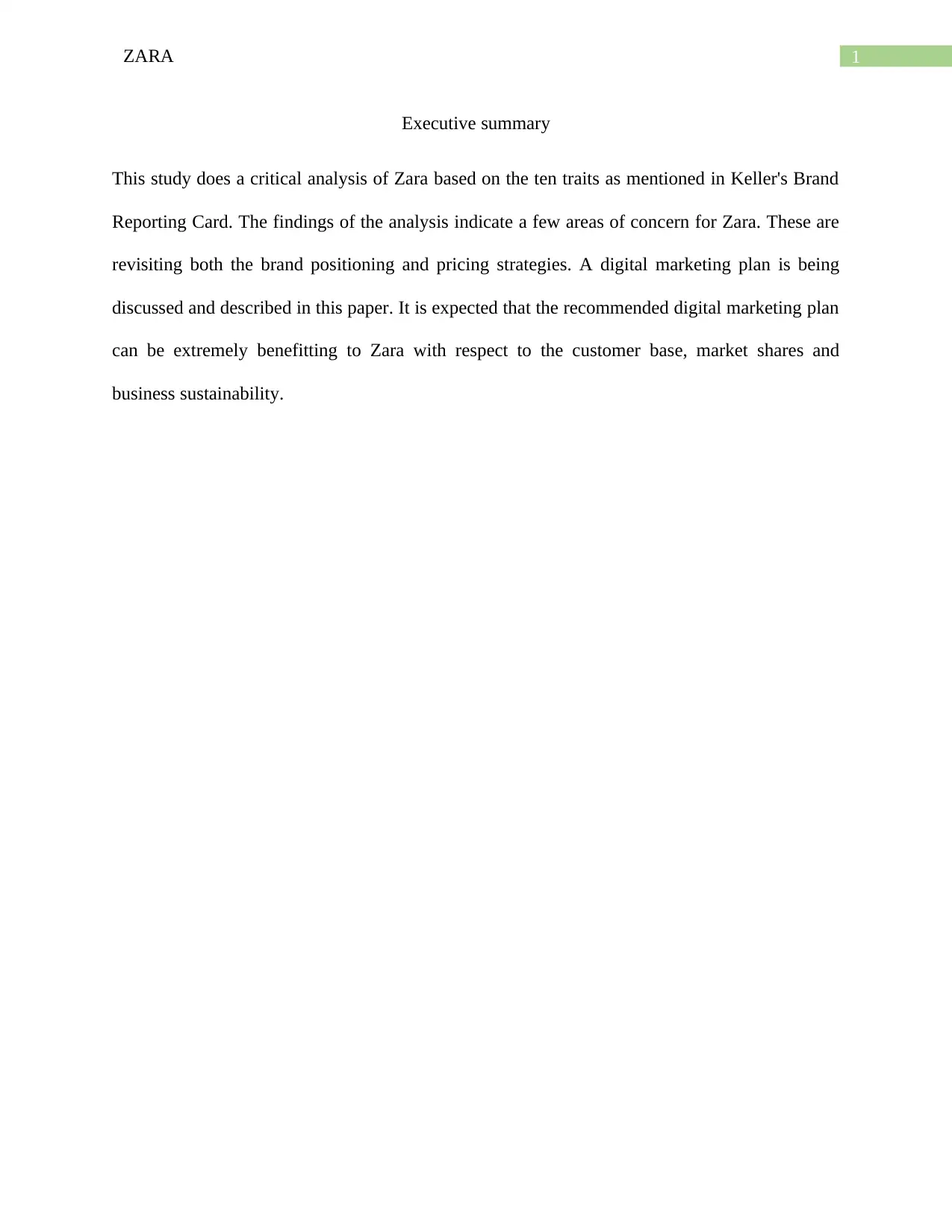
1ZARA
Executive summary
This study does a critical analysis of Zara based on the ten traits as mentioned in Keller's Brand
Reporting Card. The findings of the analysis indicate a few areas of concern for Zara. These are
revisiting both the brand positioning and pricing strategies. A digital marketing plan is being
discussed and described in this paper. It is expected that the recommended digital marketing plan
can be extremely benefitting to Zara with respect to the customer base, market shares and
business sustainability.
Executive summary
This study does a critical analysis of Zara based on the ten traits as mentioned in Keller's Brand
Reporting Card. The findings of the analysis indicate a few areas of concern for Zara. These are
revisiting both the brand positioning and pricing strategies. A digital marketing plan is being
discussed and described in this paper. It is expected that the recommended digital marketing plan
can be extremely benefitting to Zara with respect to the customer base, market shares and
business sustainability.
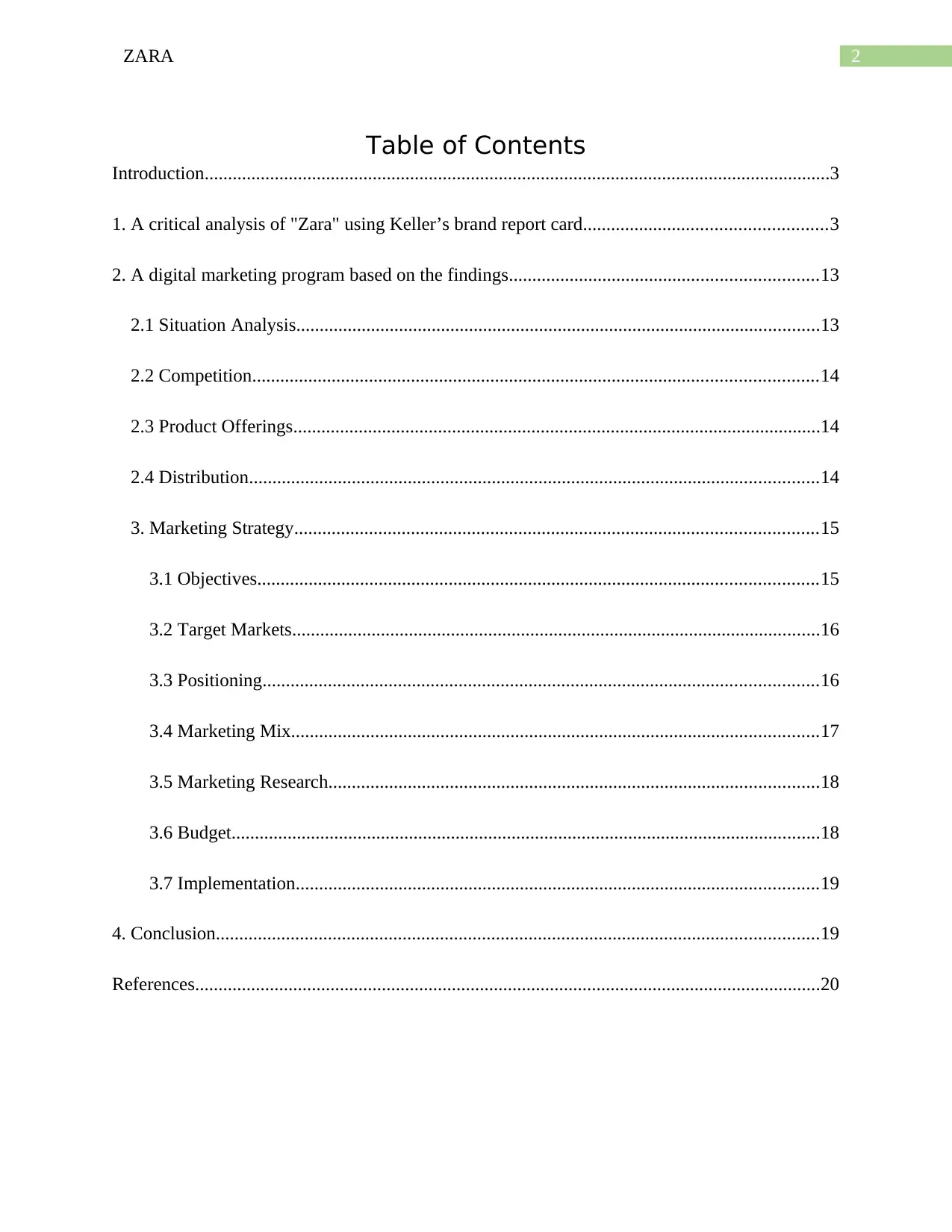
2ZARA
Table of Contents
Introduction......................................................................................................................................3
1. A critical analysis of "Zara" using Keller’s brand report card....................................................3
2. A digital marketing program based on the findings..................................................................13
2.1 Situation Analysis................................................................................................................13
2.2 Competition.........................................................................................................................14
2.3 Product Offerings.................................................................................................................14
2.4 Distribution..........................................................................................................................14
3. Marketing Strategy................................................................................................................15
3.1 Objectives........................................................................................................................15
3.2 Target Markets.................................................................................................................16
3.3 Positioning.......................................................................................................................16
3.4 Marketing Mix.................................................................................................................17
3.5 Marketing Research.........................................................................................................18
3.6 Budget..............................................................................................................................18
3.7 Implementation................................................................................................................19
4. Conclusion.................................................................................................................................19
References......................................................................................................................................20
Table of Contents
Introduction......................................................................................................................................3
1. A critical analysis of "Zara" using Keller’s brand report card....................................................3
2. A digital marketing program based on the findings..................................................................13
2.1 Situation Analysis................................................................................................................13
2.2 Competition.........................................................................................................................14
2.3 Product Offerings.................................................................................................................14
2.4 Distribution..........................................................................................................................14
3. Marketing Strategy................................................................................................................15
3.1 Objectives........................................................................................................................15
3.2 Target Markets.................................................................................................................16
3.3 Positioning.......................................................................................................................16
3.4 Marketing Mix.................................................................................................................17
3.5 Marketing Research.........................................................................................................18
3.6 Budget..............................................................................................................................18
3.7 Implementation................................................................................................................19
4. Conclusion.................................................................................................................................19
References......................................................................................................................................20
⊘ This is a preview!⊘
Do you want full access?
Subscribe today to unlock all pages.

Trusted by 1+ million students worldwide
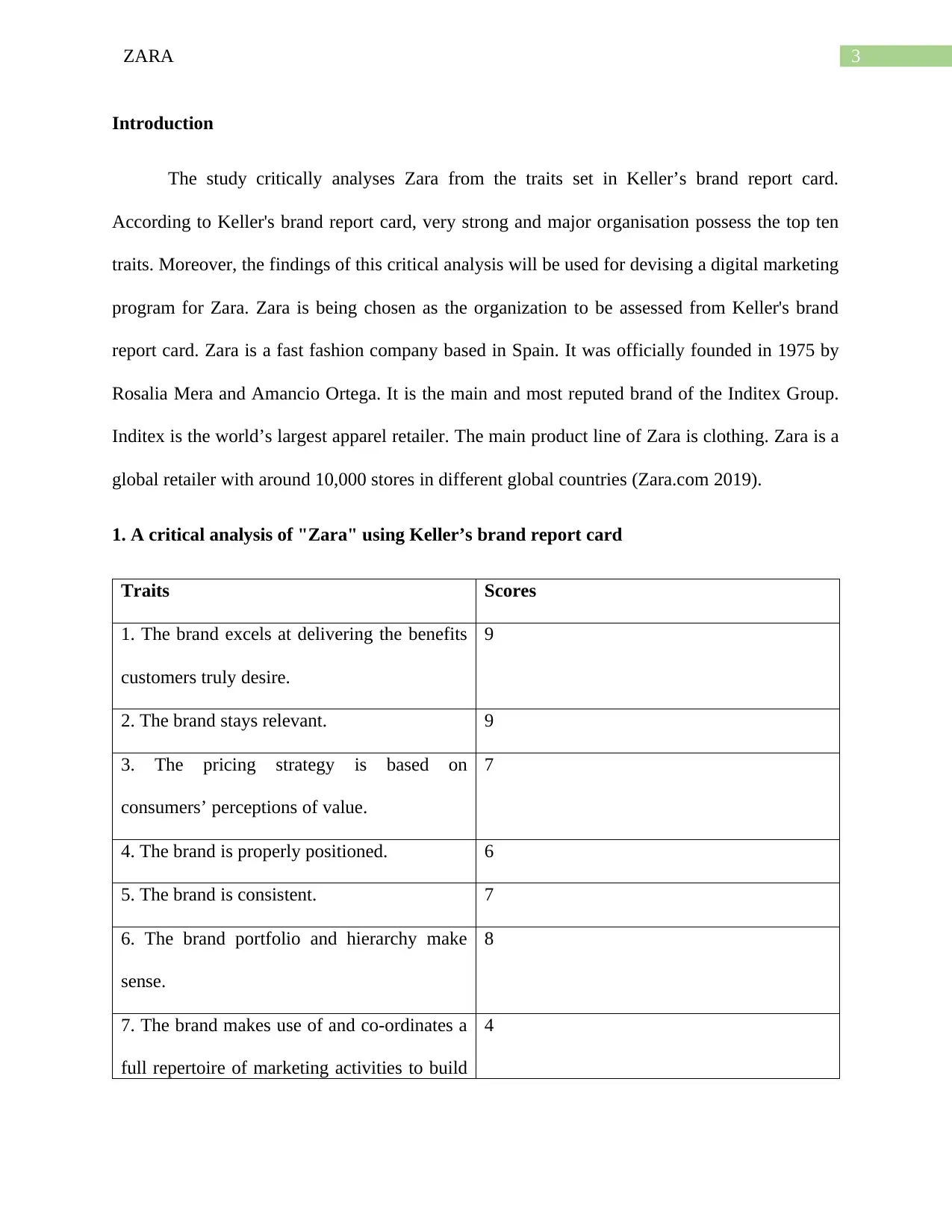
3ZARA
Introduction
The study critically analyses Zara from the traits set in Keller’s brand report card.
According to Keller's brand report card, very strong and major organisation possess the top ten
traits. Moreover, the findings of this critical analysis will be used for devising a digital marketing
program for Zara. Zara is being chosen as the organization to be assessed from Keller's brand
report card. Zara is a fast fashion company based in Spain. It was officially founded in 1975 by
Rosalia Mera and Amancio Ortega. It is the main and most reputed brand of the Inditex Group.
Inditex is the world’s largest apparel retailer. The main product line of Zara is clothing. Zara is a
global retailer with around 10,000 stores in different global countries (Zara.com 2019).
1. A critical analysis of "Zara" using Keller’s brand report card
Traits Scores
1. The brand excels at delivering the benefits
customers truly desire.
9
2. The brand stays relevant. 9
3. The pricing strategy is based on
consumers’ perceptions of value.
7
4. The brand is properly positioned. 6
5. The brand is consistent. 7
6. The brand portfolio and hierarchy make
sense.
8
7. The brand makes use of and co-ordinates a
full repertoire of marketing activities to build
4
Introduction
The study critically analyses Zara from the traits set in Keller’s brand report card.
According to Keller's brand report card, very strong and major organisation possess the top ten
traits. Moreover, the findings of this critical analysis will be used for devising a digital marketing
program for Zara. Zara is being chosen as the organization to be assessed from Keller's brand
report card. Zara is a fast fashion company based in Spain. It was officially founded in 1975 by
Rosalia Mera and Amancio Ortega. It is the main and most reputed brand of the Inditex Group.
Inditex is the world’s largest apparel retailer. The main product line of Zara is clothing. Zara is a
global retailer with around 10,000 stores in different global countries (Zara.com 2019).
1. A critical analysis of "Zara" using Keller’s brand report card
Traits Scores
1. The brand excels at delivering the benefits
customers truly desire.
9
2. The brand stays relevant. 9
3. The pricing strategy is based on
consumers’ perceptions of value.
7
4. The brand is properly positioned. 6
5. The brand is consistent. 7
6. The brand portfolio and hierarchy make
sense.
8
7. The brand makes use of and co-ordinates a
full repertoire of marketing activities to build
4
Paraphrase This Document
Need a fresh take? Get an instant paraphrase of this document with our AI Paraphraser
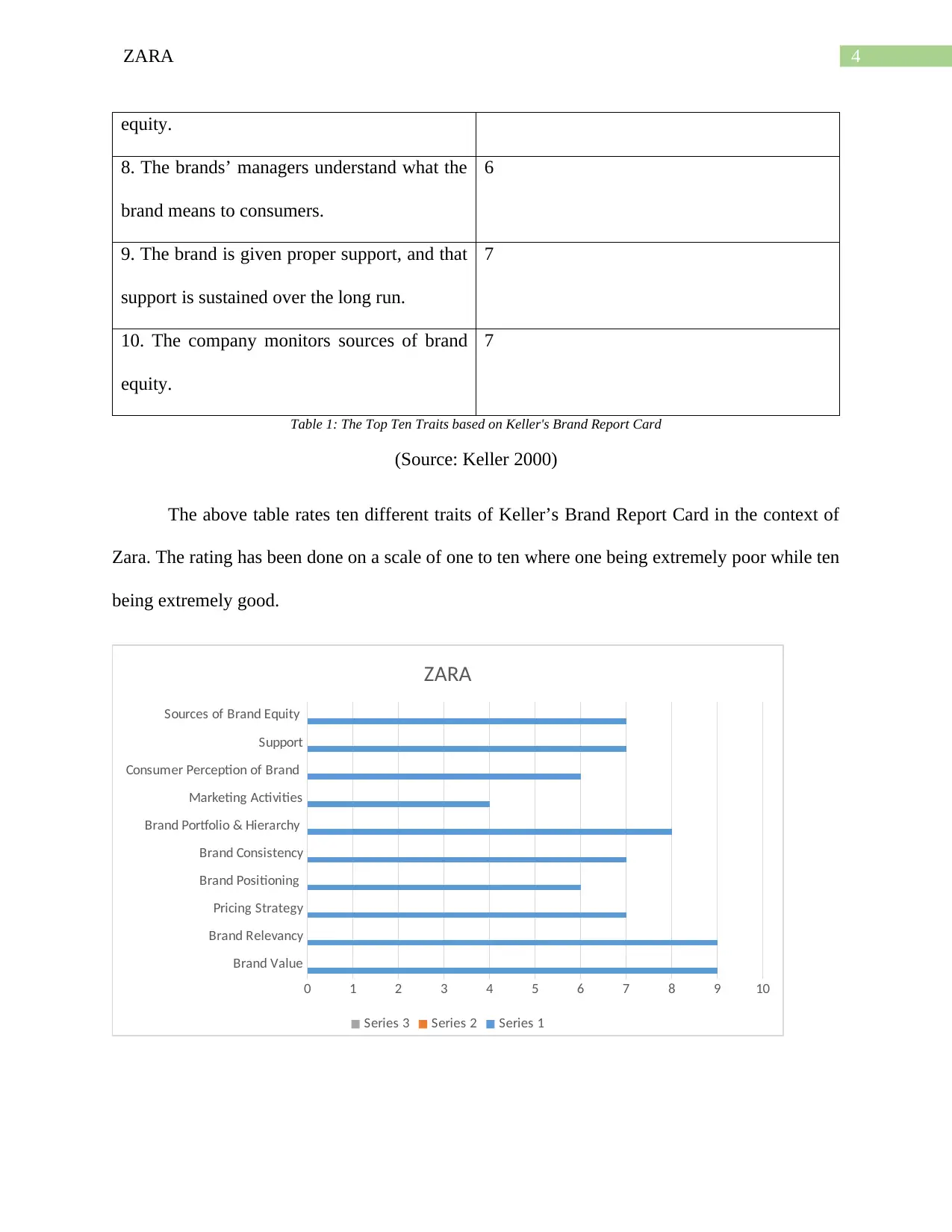
4ZARA
equity.
8. The brands’ managers understand what the
brand means to consumers.
6
9. The brand is given proper support, and that
support is sustained over the long run.
7
10. The company monitors sources of brand
equity.
7
Table 1: The Top Ten Traits based on Keller's Brand Report Card
(Source: Keller 2000)
The above table rates ten different traits of Keller’s Brand Report Card in the context of
Zara. The rating has been done on a scale of one to ten where one being extremely poor while ten
being extremely good.
Brand Value
Brand Relevancy
Pricing Strategy
Brand Positioning
Brand Consistency
Brand Portfolio & Hierarchy
Marketing Activities
Consumer Perception of Brand
Support
Sources of Brand Equity
0 1 2 3 4 5 6 7 8 9 10
ZARA
Series 3 Series 2 Series 1
equity.
8. The brands’ managers understand what the
brand means to consumers.
6
9. The brand is given proper support, and that
support is sustained over the long run.
7
10. The company monitors sources of brand
equity.
7
Table 1: The Top Ten Traits based on Keller's Brand Report Card
(Source: Keller 2000)
The above table rates ten different traits of Keller’s Brand Report Card in the context of
Zara. The rating has been done on a scale of one to ten where one being extremely poor while ten
being extremely good.
Brand Value
Brand Relevancy
Pricing Strategy
Brand Positioning
Brand Consistency
Brand Portfolio & Hierarchy
Marketing Activities
Consumer Perception of Brand
Support
Sources of Brand Equity
0 1 2 3 4 5 6 7 8 9 10
ZARA
Series 3 Series 2 Series 1
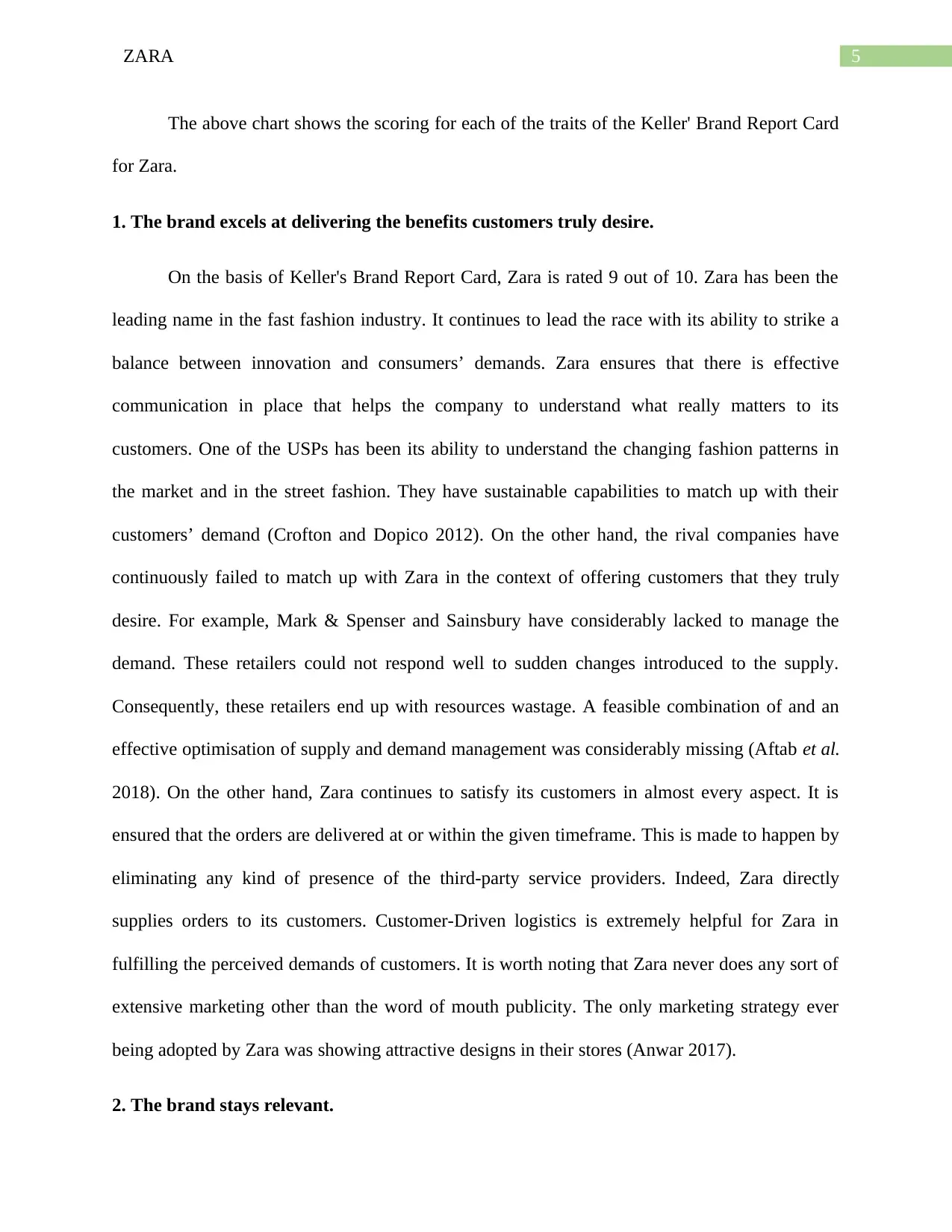
5ZARA
The above chart shows the scoring for each of the traits of the Keller' Brand Report Card
for Zara.
1. The brand excels at delivering the benefits customers truly desire.
On the basis of Keller's Brand Report Card, Zara is rated 9 out of 10. Zara has been the
leading name in the fast fashion industry. It continues to lead the race with its ability to strike a
balance between innovation and consumers’ demands. Zara ensures that there is effective
communication in place that helps the company to understand what really matters to its
customers. One of the USPs has been its ability to understand the changing fashion patterns in
the market and in the street fashion. They have sustainable capabilities to match up with their
customers’ demand (Crofton and Dopico 2012). On the other hand, the rival companies have
continuously failed to match up with Zara in the context of offering customers that they truly
desire. For example, Mark & Spenser and Sainsbury have considerably lacked to manage the
demand. These retailers could not respond well to sudden changes introduced to the supply.
Consequently, these retailers end up with resources wastage. A feasible combination of and an
effective optimisation of supply and demand management was considerably missing (Aftab et al.
2018). On the other hand, Zara continues to satisfy its customers in almost every aspect. It is
ensured that the orders are delivered at or within the given timeframe. This is made to happen by
eliminating any kind of presence of the third-party service providers. Indeed, Zara directly
supplies orders to its customers. Customer-Driven logistics is extremely helpful for Zara in
fulfilling the perceived demands of customers. It is worth noting that Zara never does any sort of
extensive marketing other than the word of mouth publicity. The only marketing strategy ever
being adopted by Zara was showing attractive designs in their stores (Anwar 2017).
2. The brand stays relevant.
The above chart shows the scoring for each of the traits of the Keller' Brand Report Card
for Zara.
1. The brand excels at delivering the benefits customers truly desire.
On the basis of Keller's Brand Report Card, Zara is rated 9 out of 10. Zara has been the
leading name in the fast fashion industry. It continues to lead the race with its ability to strike a
balance between innovation and consumers’ demands. Zara ensures that there is effective
communication in place that helps the company to understand what really matters to its
customers. One of the USPs has been its ability to understand the changing fashion patterns in
the market and in the street fashion. They have sustainable capabilities to match up with their
customers’ demand (Crofton and Dopico 2012). On the other hand, the rival companies have
continuously failed to match up with Zara in the context of offering customers that they truly
desire. For example, Mark & Spenser and Sainsbury have considerably lacked to manage the
demand. These retailers could not respond well to sudden changes introduced to the supply.
Consequently, these retailers end up with resources wastage. A feasible combination of and an
effective optimisation of supply and demand management was considerably missing (Aftab et al.
2018). On the other hand, Zara continues to satisfy its customers in almost every aspect. It is
ensured that the orders are delivered at or within the given timeframe. This is made to happen by
eliminating any kind of presence of the third-party service providers. Indeed, Zara directly
supplies orders to its customers. Customer-Driven logistics is extremely helpful for Zara in
fulfilling the perceived demands of customers. It is worth noting that Zara never does any sort of
extensive marketing other than the word of mouth publicity. The only marketing strategy ever
being adopted by Zara was showing attractive designs in their stores (Anwar 2017).
2. The brand stays relevant.
⊘ This is a preview!⊘
Do you want full access?
Subscribe today to unlock all pages.

Trusted by 1+ million students worldwide
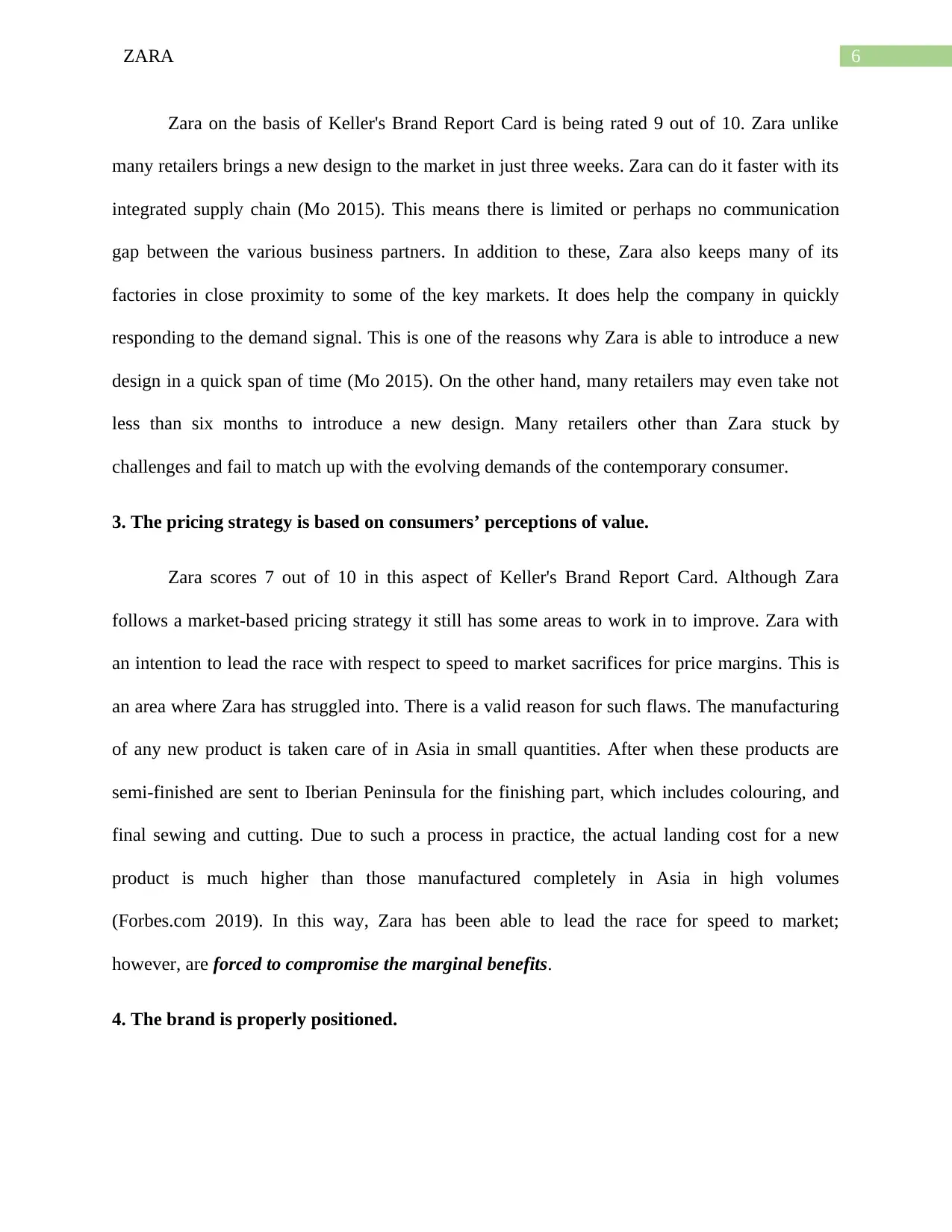
6ZARA
Zara on the basis of Keller's Brand Report Card is being rated 9 out of 10. Zara unlike
many retailers brings a new design to the market in just three weeks. Zara can do it faster with its
integrated supply chain (Mo 2015). This means there is limited or perhaps no communication
gap between the various business partners. In addition to these, Zara also keeps many of its
factories in close proximity to some of the key markets. It does help the company in quickly
responding to the demand signal. This is one of the reasons why Zara is able to introduce a new
design in a quick span of time (Mo 2015). On the other hand, many retailers may even take not
less than six months to introduce a new design. Many retailers other than Zara stuck by
challenges and fail to match up with the evolving demands of the contemporary consumer.
3. The pricing strategy is based on consumers’ perceptions of value.
Zara scores 7 out of 10 in this aspect of Keller's Brand Report Card. Although Zara
follows a market-based pricing strategy it still has some areas to work in to improve. Zara with
an intention to lead the race with respect to speed to market sacrifices for price margins. This is
an area where Zara has struggled into. There is a valid reason for such flaws. The manufacturing
of any new product is taken care of in Asia in small quantities. After when these products are
semi-finished are sent to Iberian Peninsula for the finishing part, which includes colouring, and
final sewing and cutting. Due to such a process in practice, the actual landing cost for a new
product is much higher than those manufactured completely in Asia in high volumes
(Forbes.com 2019). In this way, Zara has been able to lead the race for speed to market;
however, are forced to compromise the marginal benefits.
4. The brand is properly positioned.
Zara on the basis of Keller's Brand Report Card is being rated 9 out of 10. Zara unlike
many retailers brings a new design to the market in just three weeks. Zara can do it faster with its
integrated supply chain (Mo 2015). This means there is limited or perhaps no communication
gap between the various business partners. In addition to these, Zara also keeps many of its
factories in close proximity to some of the key markets. It does help the company in quickly
responding to the demand signal. This is one of the reasons why Zara is able to introduce a new
design in a quick span of time (Mo 2015). On the other hand, many retailers may even take not
less than six months to introduce a new design. Many retailers other than Zara stuck by
challenges and fail to match up with the evolving demands of the contemporary consumer.
3. The pricing strategy is based on consumers’ perceptions of value.
Zara scores 7 out of 10 in this aspect of Keller's Brand Report Card. Although Zara
follows a market-based pricing strategy it still has some areas to work in to improve. Zara with
an intention to lead the race with respect to speed to market sacrifices for price margins. This is
an area where Zara has struggled into. There is a valid reason for such flaws. The manufacturing
of any new product is taken care of in Asia in small quantities. After when these products are
semi-finished are sent to Iberian Peninsula for the finishing part, which includes colouring, and
final sewing and cutting. Due to such a process in practice, the actual landing cost for a new
product is much higher than those manufactured completely in Asia in high volumes
(Forbes.com 2019). In this way, Zara has been able to lead the race for speed to market;
however, are forced to compromise the marginal benefits.
4. The brand is properly positioned.
Paraphrase This Document
Need a fresh take? Get an instant paraphrase of this document with our AI Paraphraser
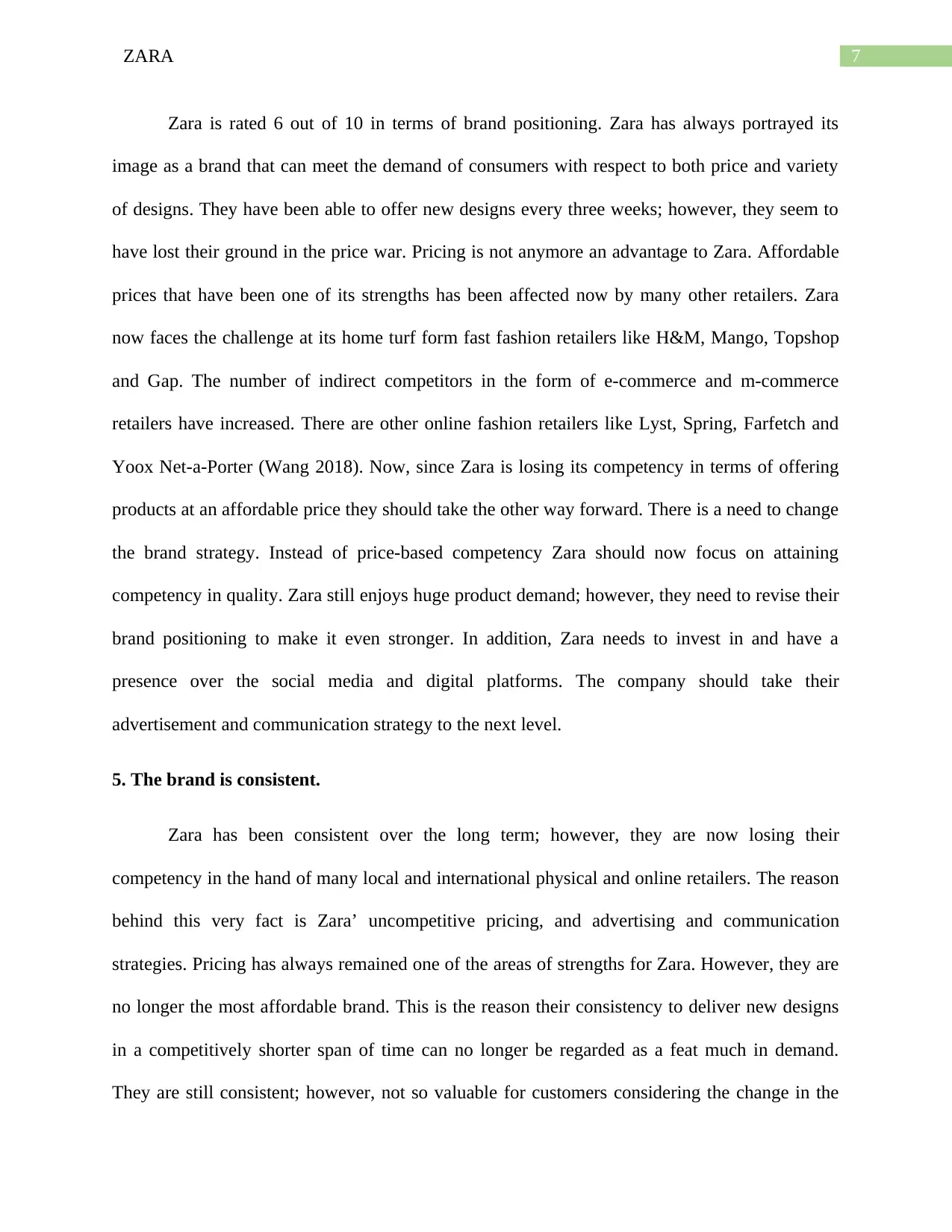
7ZARA
Zara is rated 6 out of 10 in terms of brand positioning. Zara has always portrayed its
image as a brand that can meet the demand of consumers with respect to both price and variety
of designs. They have been able to offer new designs every three weeks; however, they seem to
have lost their ground in the price war. Pricing is not anymore an advantage to Zara. Affordable
prices that have been one of its strengths has been affected now by many other retailers. Zara
now faces the challenge at its home turf form fast fashion retailers like H&M, Mango, Topshop
and Gap. The number of indirect competitors in the form of e-commerce and m-commerce
retailers have increased. There are other online fashion retailers like Lyst, Spring, Farfetch and
Yoox Net-a-Porter (Wang 2018). Now, since Zara is losing its competency in terms of offering
products at an affordable price they should take the other way forward. There is a need to change
the brand strategy. Instead of price-based competency Zara should now focus on attaining
competency in quality. Zara still enjoys huge product demand; however, they need to revise their
brand positioning to make it even stronger. In addition, Zara needs to invest in and have a
presence over the social media and digital platforms. The company should take their
advertisement and communication strategy to the next level.
5. The brand is consistent.
Zara has been consistent over the long term; however, they are now losing their
competency in the hand of many local and international physical and online retailers. The reason
behind this very fact is Zara’ uncompetitive pricing, and advertising and communication
strategies. Pricing has always remained one of the areas of strengths for Zara. However, they are
no longer the most affordable brand. This is the reason their consistency to deliver new designs
in a competitively shorter span of time can no longer be regarded as a feat much in demand.
They are still consistent; however, not so valuable for customers considering the change in the
Zara is rated 6 out of 10 in terms of brand positioning. Zara has always portrayed its
image as a brand that can meet the demand of consumers with respect to both price and variety
of designs. They have been able to offer new designs every three weeks; however, they seem to
have lost their ground in the price war. Pricing is not anymore an advantage to Zara. Affordable
prices that have been one of its strengths has been affected now by many other retailers. Zara
now faces the challenge at its home turf form fast fashion retailers like H&M, Mango, Topshop
and Gap. The number of indirect competitors in the form of e-commerce and m-commerce
retailers have increased. There are other online fashion retailers like Lyst, Spring, Farfetch and
Yoox Net-a-Porter (Wang 2018). Now, since Zara is losing its competency in terms of offering
products at an affordable price they should take the other way forward. There is a need to change
the brand strategy. Instead of price-based competency Zara should now focus on attaining
competency in quality. Zara still enjoys huge product demand; however, they need to revise their
brand positioning to make it even stronger. In addition, Zara needs to invest in and have a
presence over the social media and digital platforms. The company should take their
advertisement and communication strategy to the next level.
5. The brand is consistent.
Zara has been consistent over the long term; however, they are now losing their
competency in the hand of many local and international physical and online retailers. The reason
behind this very fact is Zara’ uncompetitive pricing, and advertising and communication
strategies. Pricing has always remained one of the areas of strengths for Zara. However, they are
no longer the most affordable brand. This is the reason their consistency to deliver new designs
in a competitively shorter span of time can no longer be regarded as a feat much in demand.
They are still consistent; however, not so valuable for customers considering the change in the
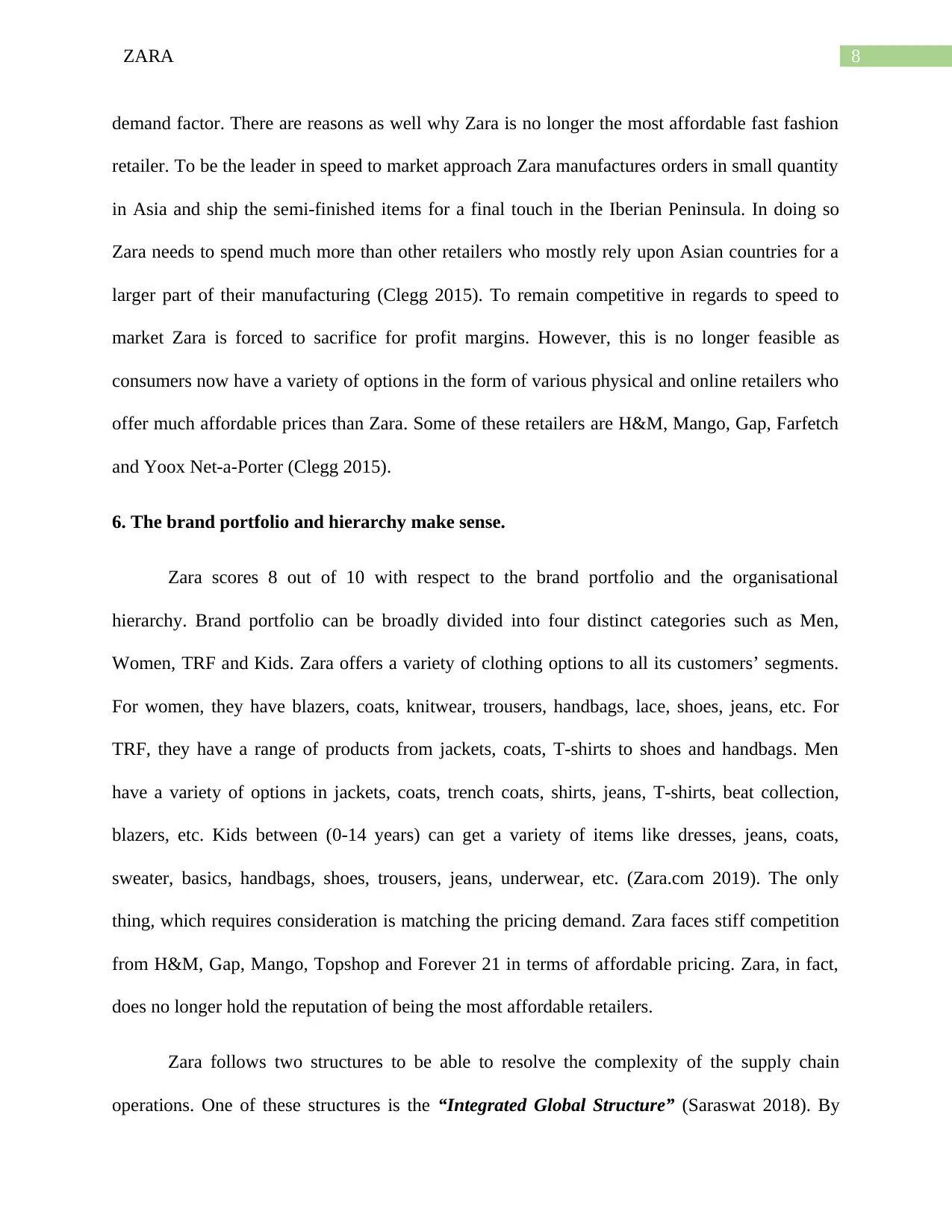
8ZARA
demand factor. There are reasons as well why Zara is no longer the most affordable fast fashion
retailer. To be the leader in speed to market approach Zara manufactures orders in small quantity
in Asia and ship the semi-finished items for a final touch in the Iberian Peninsula. In doing so
Zara needs to spend much more than other retailers who mostly rely upon Asian countries for a
larger part of their manufacturing (Clegg 2015). To remain competitive in regards to speed to
market Zara is forced to sacrifice for profit margins. However, this is no longer feasible as
consumers now have a variety of options in the form of various physical and online retailers who
offer much affordable prices than Zara. Some of these retailers are H&M, Mango, Gap, Farfetch
and Yoox Net-a-Porter (Clegg 2015).
6. The brand portfolio and hierarchy make sense.
Zara scores 8 out of 10 with respect to the brand portfolio and the organisational
hierarchy. Brand portfolio can be broadly divided into four distinct categories such as Men,
Women, TRF and Kids. Zara offers a variety of clothing options to all its customers’ segments.
For women, they have blazers, coats, knitwear, trousers, handbags, lace, shoes, jeans, etc. For
TRF, they have a range of products from jackets, coats, T-shirts to shoes and handbags. Men
have a variety of options in jackets, coats, trench coats, shirts, jeans, T-shirts, beat collection,
blazers, etc. Kids between (0-14 years) can get a variety of items like dresses, jeans, coats,
sweater, basics, handbags, shoes, trousers, jeans, underwear, etc. (Zara.com 2019). The only
thing, which requires consideration is matching the pricing demand. Zara faces stiff competition
from H&M, Gap, Mango, Topshop and Forever 21 in terms of affordable pricing. Zara, in fact,
does no longer hold the reputation of being the most affordable retailers.
Zara follows two structures to be able to resolve the complexity of the supply chain
operations. One of these structures is the “Integrated Global Structure” (Saraswat 2018). By
demand factor. There are reasons as well why Zara is no longer the most affordable fast fashion
retailer. To be the leader in speed to market approach Zara manufactures orders in small quantity
in Asia and ship the semi-finished items for a final touch in the Iberian Peninsula. In doing so
Zara needs to spend much more than other retailers who mostly rely upon Asian countries for a
larger part of their manufacturing (Clegg 2015). To remain competitive in regards to speed to
market Zara is forced to sacrifice for profit margins. However, this is no longer feasible as
consumers now have a variety of options in the form of various physical and online retailers who
offer much affordable prices than Zara. Some of these retailers are H&M, Mango, Gap, Farfetch
and Yoox Net-a-Porter (Clegg 2015).
6. The brand portfolio and hierarchy make sense.
Zara scores 8 out of 10 with respect to the brand portfolio and the organisational
hierarchy. Brand portfolio can be broadly divided into four distinct categories such as Men,
Women, TRF and Kids. Zara offers a variety of clothing options to all its customers’ segments.
For women, they have blazers, coats, knitwear, trousers, handbags, lace, shoes, jeans, etc. For
TRF, they have a range of products from jackets, coats, T-shirts to shoes and handbags. Men
have a variety of options in jackets, coats, trench coats, shirts, jeans, T-shirts, beat collection,
blazers, etc. Kids between (0-14 years) can get a variety of items like dresses, jeans, coats,
sweater, basics, handbags, shoes, trousers, jeans, underwear, etc. (Zara.com 2019). The only
thing, which requires consideration is matching the pricing demand. Zara faces stiff competition
from H&M, Gap, Mango, Topshop and Forever 21 in terms of affordable pricing. Zara, in fact,
does no longer hold the reputation of being the most affordable retailers.
Zara follows two structures to be able to resolve the complexity of the supply chain
operations. One of these structures is the “Integrated Global Structure” (Saraswat 2018). By
⊘ This is a preview!⊘
Do you want full access?
Subscribe today to unlock all pages.

Trusted by 1+ million students worldwide
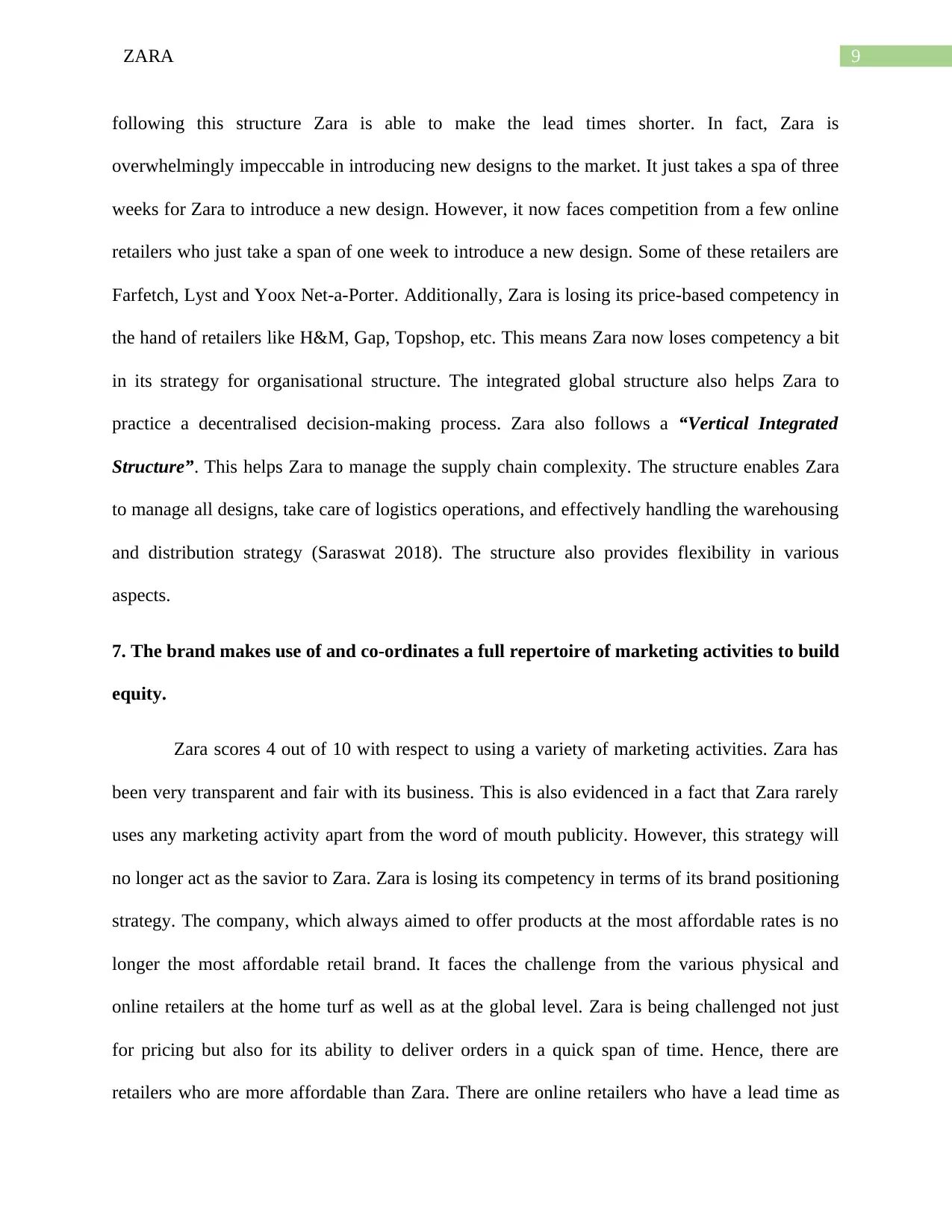
9ZARA
following this structure Zara is able to make the lead times shorter. In fact, Zara is
overwhelmingly impeccable in introducing new designs to the market. It just takes a spa of three
weeks for Zara to introduce a new design. However, it now faces competition from a few online
retailers who just take a span of one week to introduce a new design. Some of these retailers are
Farfetch, Lyst and Yoox Net-a-Porter. Additionally, Zara is losing its price-based competency in
the hand of retailers like H&M, Gap, Topshop, etc. This means Zara now loses competency a bit
in its strategy for organisational structure. The integrated global structure also helps Zara to
practice a decentralised decision-making process. Zara also follows a “Vertical Integrated
Structure”. This helps Zara to manage the supply chain complexity. The structure enables Zara
to manage all designs, take care of logistics operations, and effectively handling the warehousing
and distribution strategy (Saraswat 2018). The structure also provides flexibility in various
aspects.
7. The brand makes use of and co-ordinates a full repertoire of marketing activities to build
equity.
Zara scores 4 out of 10 with respect to using a variety of marketing activities. Zara has
been very transparent and fair with its business. This is also evidenced in a fact that Zara rarely
uses any marketing activity apart from the word of mouth publicity. However, this strategy will
no longer act as the savior to Zara. Zara is losing its competency in terms of its brand positioning
strategy. The company, which always aimed to offer products at the most affordable rates is no
longer the most affordable retail brand. It faces the challenge from the various physical and
online retailers at the home turf as well as at the global level. Zara is being challenged not just
for pricing but also for its ability to deliver orders in a quick span of time. Hence, there are
retailers who are more affordable than Zara. There are online retailers who have a lead time as
following this structure Zara is able to make the lead times shorter. In fact, Zara is
overwhelmingly impeccable in introducing new designs to the market. It just takes a spa of three
weeks for Zara to introduce a new design. However, it now faces competition from a few online
retailers who just take a span of one week to introduce a new design. Some of these retailers are
Farfetch, Lyst and Yoox Net-a-Porter. Additionally, Zara is losing its price-based competency in
the hand of retailers like H&M, Gap, Topshop, etc. This means Zara now loses competency a bit
in its strategy for organisational structure. The integrated global structure also helps Zara to
practice a decentralised decision-making process. Zara also follows a “Vertical Integrated
Structure”. This helps Zara to manage the supply chain complexity. The structure enables Zara
to manage all designs, take care of logistics operations, and effectively handling the warehousing
and distribution strategy (Saraswat 2018). The structure also provides flexibility in various
aspects.
7. The brand makes use of and co-ordinates a full repertoire of marketing activities to build
equity.
Zara scores 4 out of 10 with respect to using a variety of marketing activities. Zara has
been very transparent and fair with its business. This is also evidenced in a fact that Zara rarely
uses any marketing activity apart from the word of mouth publicity. However, this strategy will
no longer act as the savior to Zara. Zara is losing its competency in terms of its brand positioning
strategy. The company, which always aimed to offer products at the most affordable rates is no
longer the most affordable retail brand. It faces the challenge from the various physical and
online retailers at the home turf as well as at the global level. Zara is being challenged not just
for pricing but also for its ability to deliver orders in a quick span of time. Hence, there are
retailers who are more affordable than Zara. There are online retailers who have a lead time as
Paraphrase This Document
Need a fresh take? Get an instant paraphrase of this document with our AI Paraphraser
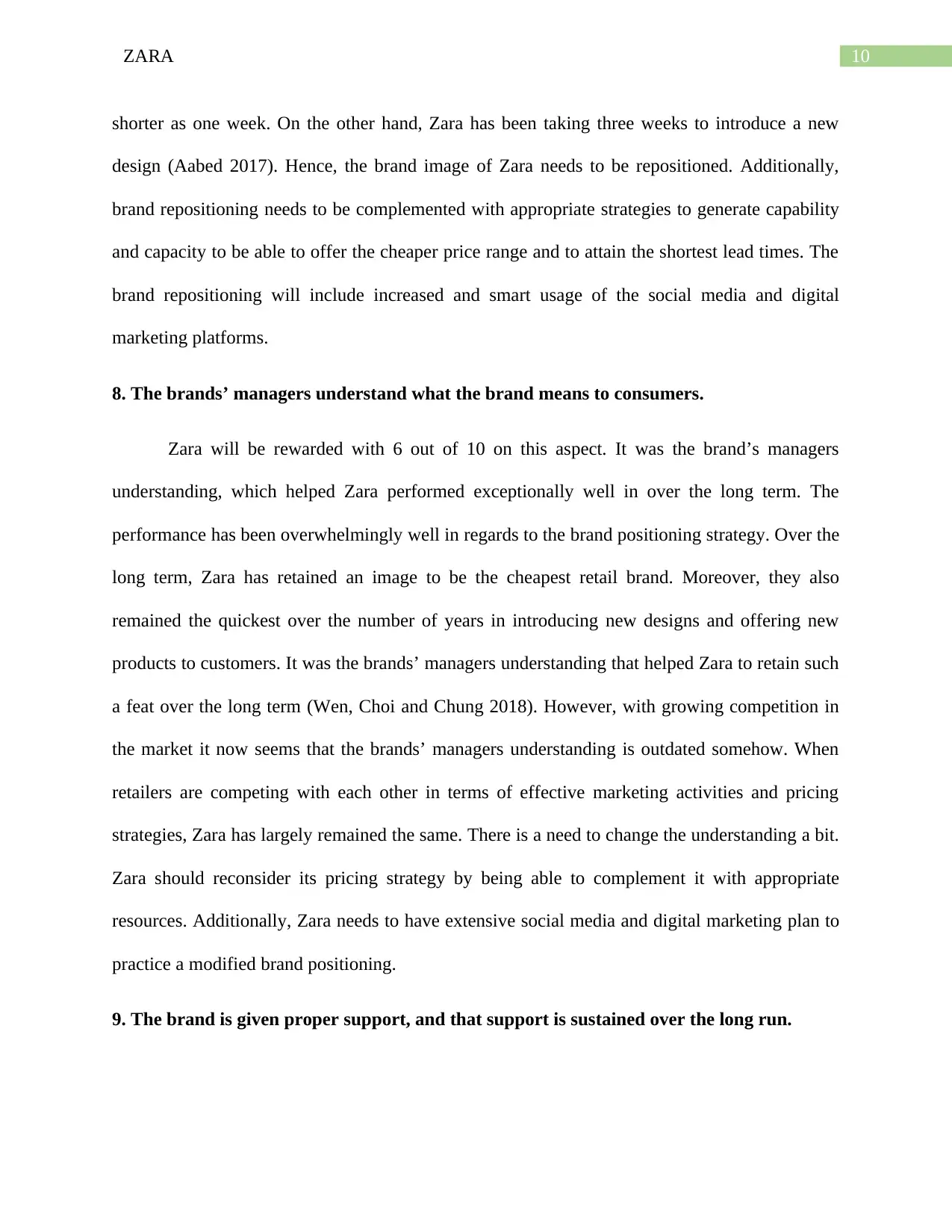
10ZARA
shorter as one week. On the other hand, Zara has been taking three weeks to introduce a new
design (Aabed 2017). Hence, the brand image of Zara needs to be repositioned. Additionally,
brand repositioning needs to be complemented with appropriate strategies to generate capability
and capacity to be able to offer the cheaper price range and to attain the shortest lead times. The
brand repositioning will include increased and smart usage of the social media and digital
marketing platforms.
8. The brands’ managers understand what the brand means to consumers.
Zara will be rewarded with 6 out of 10 on this aspect. It was the brand’s managers
understanding, which helped Zara performed exceptionally well in over the long term. The
performance has been overwhelmingly well in regards to the brand positioning strategy. Over the
long term, Zara has retained an image to be the cheapest retail brand. Moreover, they also
remained the quickest over the number of years in introducing new designs and offering new
products to customers. It was the brands’ managers understanding that helped Zara to retain such
a feat over the long term (Wen, Choi and Chung 2018). However, with growing competition in
the market it now seems that the brands’ managers understanding is outdated somehow. When
retailers are competing with each other in terms of effective marketing activities and pricing
strategies, Zara has largely remained the same. There is a need to change the understanding a bit.
Zara should reconsider its pricing strategy by being able to complement it with appropriate
resources. Additionally, Zara needs to have extensive social media and digital marketing plan to
practice a modified brand positioning.
9. The brand is given proper support, and that support is sustained over the long run.
shorter as one week. On the other hand, Zara has been taking three weeks to introduce a new
design (Aabed 2017). Hence, the brand image of Zara needs to be repositioned. Additionally,
brand repositioning needs to be complemented with appropriate strategies to generate capability
and capacity to be able to offer the cheaper price range and to attain the shortest lead times. The
brand repositioning will include increased and smart usage of the social media and digital
marketing platforms.
8. The brands’ managers understand what the brand means to consumers.
Zara will be rewarded with 6 out of 10 on this aspect. It was the brand’s managers
understanding, which helped Zara performed exceptionally well in over the long term. The
performance has been overwhelmingly well in regards to the brand positioning strategy. Over the
long term, Zara has retained an image to be the cheapest retail brand. Moreover, they also
remained the quickest over the number of years in introducing new designs and offering new
products to customers. It was the brands’ managers understanding that helped Zara to retain such
a feat over the long term (Wen, Choi and Chung 2018). However, with growing competition in
the market it now seems that the brands’ managers understanding is outdated somehow. When
retailers are competing with each other in terms of effective marketing activities and pricing
strategies, Zara has largely remained the same. There is a need to change the understanding a bit.
Zara should reconsider its pricing strategy by being able to complement it with appropriate
resources. Additionally, Zara needs to have extensive social media and digital marketing plan to
practice a modified brand positioning.
9. The brand is given proper support, and that support is sustained over the long run.
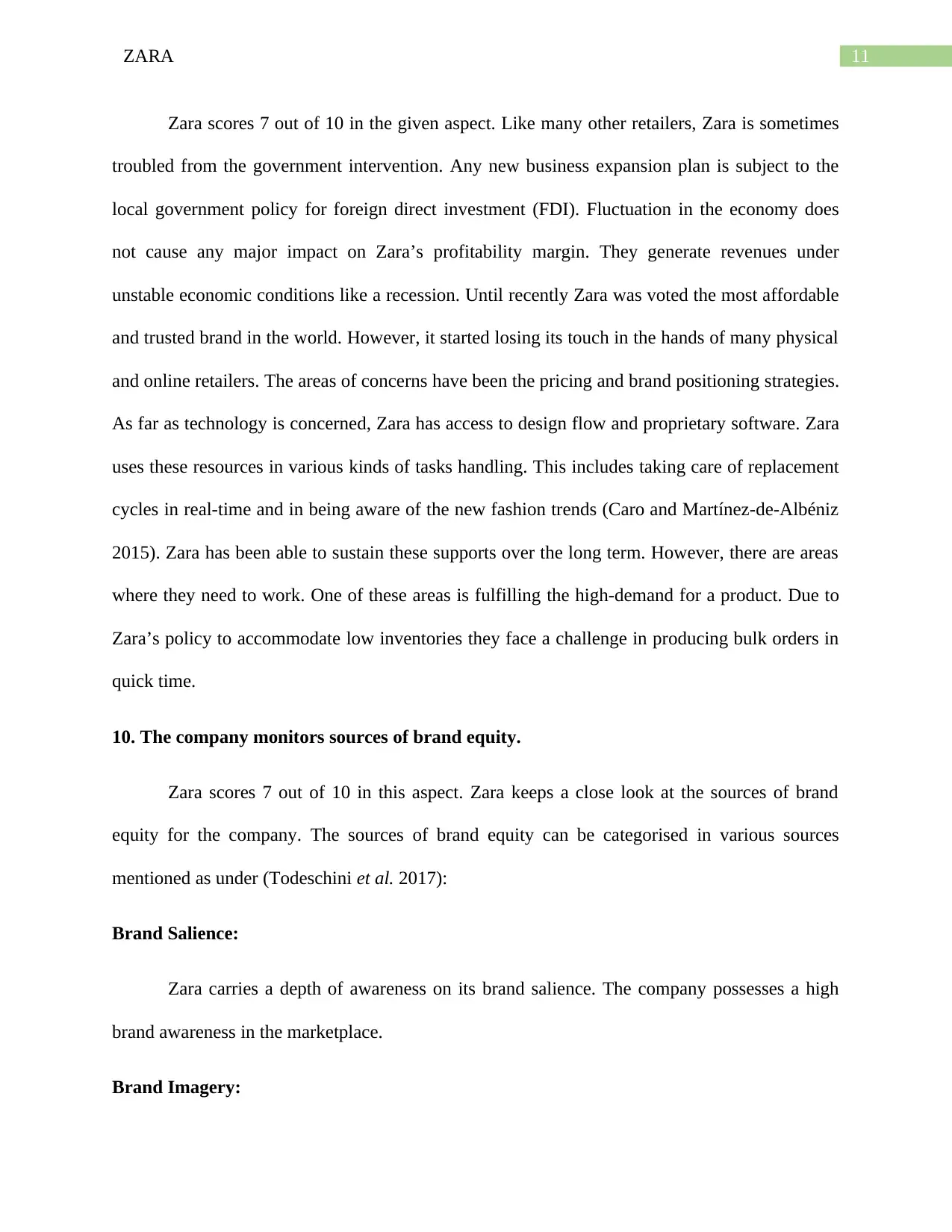
11ZARA
Zara scores 7 out of 10 in the given aspect. Like many other retailers, Zara is sometimes
troubled from the government intervention. Any new business expansion plan is subject to the
local government policy for foreign direct investment (FDI). Fluctuation in the economy does
not cause any major impact on Zara’s profitability margin. They generate revenues under
unstable economic conditions like a recession. Until recently Zara was voted the most affordable
and trusted brand in the world. However, it started losing its touch in the hands of many physical
and online retailers. The areas of concerns have been the pricing and brand positioning strategies.
As far as technology is concerned, Zara has access to design flow and proprietary software. Zara
uses these resources in various kinds of tasks handling. This includes taking care of replacement
cycles in real-time and in being aware of the new fashion trends (Caro and Martínez-de-Albéniz
2015). Zara has been able to sustain these supports over the long term. However, there are areas
where they need to work. One of these areas is fulfilling the high-demand for a product. Due to
Zara’s policy to accommodate low inventories they face a challenge in producing bulk orders in
quick time.
10. The company monitors sources of brand equity.
Zara scores 7 out of 10 in this aspect. Zara keeps a close look at the sources of brand
equity for the company. The sources of brand equity can be categorised in various sources
mentioned as under (Todeschini et al. 2017):
Brand Salience:
Zara carries a depth of awareness on its brand salience. The company possesses a high
brand awareness in the marketplace.
Brand Imagery:
Zara scores 7 out of 10 in the given aspect. Like many other retailers, Zara is sometimes
troubled from the government intervention. Any new business expansion plan is subject to the
local government policy for foreign direct investment (FDI). Fluctuation in the economy does
not cause any major impact on Zara’s profitability margin. They generate revenues under
unstable economic conditions like a recession. Until recently Zara was voted the most affordable
and trusted brand in the world. However, it started losing its touch in the hands of many physical
and online retailers. The areas of concerns have been the pricing and brand positioning strategies.
As far as technology is concerned, Zara has access to design flow and proprietary software. Zara
uses these resources in various kinds of tasks handling. This includes taking care of replacement
cycles in real-time and in being aware of the new fashion trends (Caro and Martínez-de-Albéniz
2015). Zara has been able to sustain these supports over the long term. However, there are areas
where they need to work. One of these areas is fulfilling the high-demand for a product. Due to
Zara’s policy to accommodate low inventories they face a challenge in producing bulk orders in
quick time.
10. The company monitors sources of brand equity.
Zara scores 7 out of 10 in this aspect. Zara keeps a close look at the sources of brand
equity for the company. The sources of brand equity can be categorised in various sources
mentioned as under (Todeschini et al. 2017):
Brand Salience:
Zara carries a depth of awareness on its brand salience. The company possesses a high
brand awareness in the marketplace.
Brand Imagery:
⊘ This is a preview!⊘
Do you want full access?
Subscribe today to unlock all pages.

Trusted by 1+ million students worldwide
1 out of 22
Related Documents
Your All-in-One AI-Powered Toolkit for Academic Success.
+13062052269
info@desklib.com
Available 24*7 on WhatsApp / Email
![[object Object]](/_next/static/media/star-bottom.7253800d.svg)
Unlock your academic potential
Copyright © 2020–2025 A2Z Services. All Rights Reserved. Developed and managed by ZUCOL.




